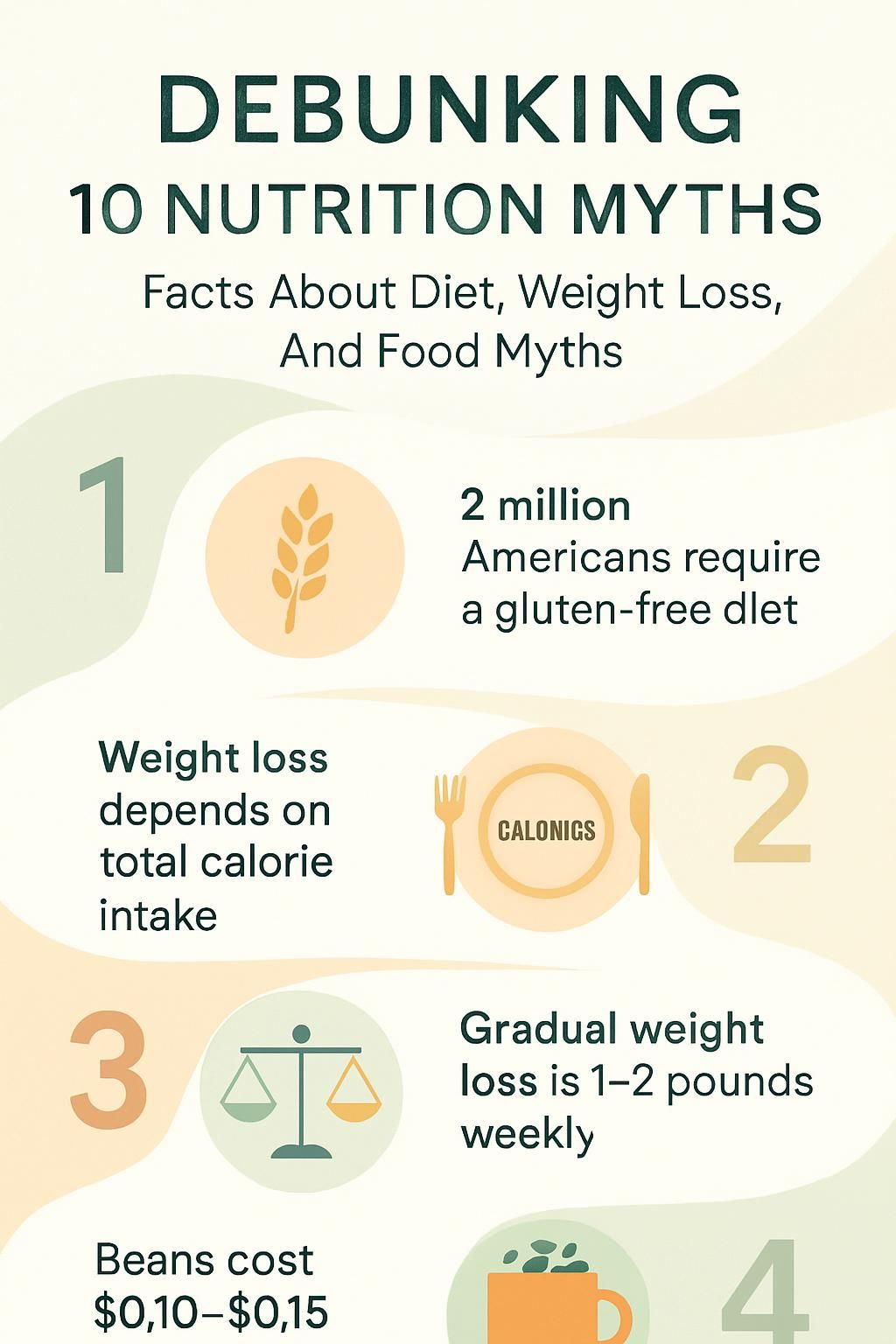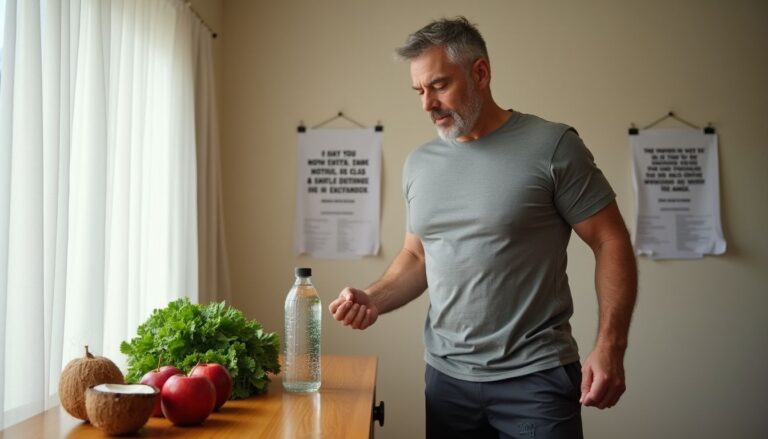Debunking 10 Nutrition Myths: Facts About Diet, Weight Loss, And Food Myths
Our Nutrition Assistant AI Suite will transform your body. You will lose fat, get toned, and build muscle. Gain confidence and optimal health.
Sorting facts from nutrition myths can feel hard. Misinformation spreads fast online and can lead to choices that do not help your health or weight loss goals. Here, you will see 10 common food myths debunked using research and clear steps you can use today.
Each section shares simple actions, brief data points, and a quick recap. With small changes, you can build a healthy diet, protect your heart, and maintain a healthy weight.
Key Takeaways
- Healthy eating can be budget friendly. Beans, brown rice at about $0.10–$0.15 per cooked cup, and frozen vegetables are low-cost staples (USDA, 2023).
- Only people with celiac disease or confirmed gluten sensitivity need a gluten-free diet. Most others do better with whole grains (NIDDK).
- Weight loss depends most on total calories over time, not meal timing or special “fat-burning” foods.
- Many low-fat items add sugar or salt to improve taste. Read the nutrition facts label to spot hidden ingredients.
- Gradual loss of 1–2 pounds per week, along with balanced meals and at least 150 minutes of weekly physical activity, supports long-term success (CDC).

Myth 1: Eating Healthy is Costly

Many people repeat food myths that eating well always costs more. In reality, smart shopping and simple cooking keep costs low while nutrition stays high.
What Are Affordable Healthy Eating Options?
Build meals with low-cost staples:
- Beans, lentils, and brown rice for protein and carbohydrates. Dried beans in bulk cost less.
- Frozen or canned fruits and vegetables, packed at peak freshness, with vitamins and minerals intact.
- Oats and whole wheat bread for dietary fiber and heart health.
- Low-cost proteins like eggs, plain yogurt, and peanut butter.
Meal planning reduces waste and helps you use what you buy. I began cooking large batches on weekends with potatoes, carrots, frozen broccoli, and chicken thighs. That one change cut costs and kept my meals balanced all week.
Small changes like switching from white bread to whole grain or adding beans instead of meat can help you eat healthier on a budget.
Mix starches like sweet potatoes with seasonal produce for balanced, filling plates. Choose snacks with fewer calories and more nutrients than chips or cookies.
Nutritional value per dollar, sample
| Food Item | Calories (per cooked cup) | Protein (g) | Average Cost |
|---|---|---|---|
| Dried Lentils | 230 | 18 | $0.15 per cup |
| Brown Rice | 216 | 5 | $0.10 per cup |
| Frozen Broccoli | 50 (per 12 oz) | 3 | $1 per 12 oz bag |
Tip: Compare unit prices, store brands, and frozen options to stretch your budget.
Myth 2: Gluten-Free Diets are Essential for Everyone
Gluten-free eating sounds like a cure-all, but this diet is only needed for specific medical reasons. Without those, it can limit healthy choices.
Who Actually Needs a Gluten-Free Diet?
Gluten is a protein in wheat, rye, and barley. In people with celiac disease, it triggers the immune system to attack the small intestine, which can cause damage and painful symptoms. About 2 million people in the United States have celiac disease (NIDDK).
Some people have non-celiac gluten sensitivity. They may feel bloating or nausea after eating gluten, but they do not have intestinal damage. If you do not have celiac disease or a diagnosed sensitivity, you do not need to avoid gluten.
Whole grains like whole wheat bread and wheat pasta provide B vitamins and dietary fiber. A friend tried to cut gluten to lose weight. A dietitian explained that skipping whole grains without a medical need can remove healthy, filling foods. Focus on varied, whole foods first.
Myth 3: High-Fat Foods Lead to Weight Gain
Fat does not automatically cause weight gain. The type and amount of fat matter most.
What Are the Benefits of Healthy Fats?
Unsaturated fats from avocados, olive oil, nuts, and seeds support heart and brain health. Omega-3 fats from fish like salmon help reduce inflammation and can improve blood pressure. Fat also helps your body absorb vitamins A, D, E, and K.
Healthy fats increase fullness, which may reduce snacking on added sugar. I started adding nut butter and a drizzle of olive oil to meals. Hunger eased between meals, and energy improved during physical activity.
The Dietary Guidelines for Americans encourage healthy fats as part of a balanced pattern, not a very low-fat diet.
Healthy fats, like those from avocados and nuts, support your body’s vital functions and may protect you from chronic conditions.
Myth 4: Carbs Are Bad for Weight Loss
Carbohydrates are not the enemy. Choosing the right carbs in the right amounts supports energy and weight goals.
Why Are Carbohydrates Important for Energy and Health?
Carbohydrates are your body’s main fuel. Your muscles and brain use glucose from carbs for work, study, and exercise. Whole grains, fruits, and vegetables supply fiber that supports digestion and steady blood sugar level.
Most people do well when 45 to 65 percent of calories come from carbohydrates, as suggested by the Dietary Guidelines for Americans. I trained for a 5K and cut carbs for a few days. My pace dropped and I felt drained. After adding whole grains and fruit, my runs felt easier and recovery improved.
Myth 5: Detox Diets Remove Toxins
Detox plans promise quick cleansing, yet your body already has a powerful detox system.
How Does Your Body Naturally Eliminate Toxins?
The liver filters and breaks down harmful substances. Kidneys remove waste through urine. The gastrointestinal tract clears waste through stool. Your lungs remove gases when you exhale, and sweat can release small amounts through your skin.
A balanced diet supports these organs. Drink water, eat fiber from whole grains and plants, and include antioxidant-rich foods like berries and leafy greens. Health professionals agree that detox teas or cleanses are not required for a healthy body.
Myth 6: Eating After 7 PM Causes Weight Gain
Late eating is not a magic switch for weight gain. Calorie intake and food quality matter much more.
Does Meal Timing Affect Metabolism and Weight Gain?
Your metabolism runs all day and night. Studies show that eating later does not automatically slow metabolism or cause fat gain. What counts is the total mix of calories and nutrients across the day.
Skipping meals can backfire and lead to overeating later. A steady meal pattern with carbohydrates, protein, and healthy fat supports energy and appetite control.
Myth 7: Some Foods Can Melt Fat
There is no single food that melts fat. Weight change comes from your habits and your calorie balance.
Can Certain Foods Boost Metabolism or Burn Fat?
Spicy foods and green tea can raise calorie burn slightly for a short time. The effect is small. Claims about grapefruit or apple cider vinegar causing major fat loss are not supported by strong research.
I tried raising protein at snacks, like Greek yogurt and tofu. The big win was better fullness, not instant fat loss from one food. Build balanced plates with whole grains, healthy fats, lean protein, and many plants.
Myth 8: Choose Low-Fat or Fat-Free Products for Health
Low-fat and fat-free labels can distract from what is inside the package.
What Are the Downsides of Low-Fat and Fat-Free Foods?
When fat is removed, companies often add sugars, salt, or starch to fix taste and texture. That can raise calories in unexpected ways. Some people also eat larger portions because the label sounds healthy.
These products may miss nutrients found in healthy fats. I felt less satisfied with fat-free yogurt than with regular yogurt, which led to more snacking. Check the nutrition facts label and ingredients. Many whole foods with natural fats, like nuts and olive oil, support heart health.
Myth 9: Only Fresh Produce is Nutritious
Fresh, frozen, and canned produce can all fit into a healthy diet. Each option has strengths.
How Nutritious Are Canned and Frozen Fruits and Vegetables?
Frozen and canned produce is often packed at peak ripeness, which helps lock in vitamins and minerals. Vitamin C and other nutrients can hold up as well as fresh, and sometimes better than fresh that sits for days.
Pick low-sodium canned beans and vegetables. Choose fruit packed in water or 100 percent juice, not syrup. Canned tomatoes are a budget-friendly base for sauces and soups with strong nutrition.
Myth 10: All Fats Are Harmful
Fat type matters. Some fats protect your heart while others raise risk.
How to Distinguish Healthy Fats from Unhealthy Ones?
Unsaturated fats, found in nuts, seeds, avocados, soybeans, and fish, support heart health. Diets high in saturated fat, common in butter, cheese, red meat, and many snacks, can raise the risk of cardiovascular disease. Keep trans fats and hydrogenated oils as low as possible.
Cook with olive oil in place of butter. I swapped regular spreads for natural peanut butter and saw my LDL cholesterol drop over six months, while breakfast stayed tasty.
Common Weight Loss Misconceptions
Confusing advice can block progress. A simple rule can cut through the noise.
Why Is Caloric Balance Important for Weight Loss?
Your body uses energy for basic functions and activity. You lose weight if you burn more calories than you eat. A daily deficit of 500 to 1,000 calories can produce about one to two pounds of loss per week.
Logging meals highlights hidden calories from sugary drinks, sauces, and large portions. I kept a journal and noticed how fast small extras added up. The same rule applies whether you prefer intermittent fasting, a low-carb plan, or another approach.
Food Choices and Inflammation
What you eat can calm or stir up inflammation, which affects long-term health.
How Does Diet Impact Inflammation?
Diets high in added sugars and highly processed foods can raise inflammatory markers like C-reactive protein. Frequent fast food and snacks high in saturated and trans fats can keep low-grade inflammation active, which raises the risk of type 2 diabetes and metabolic syndrome.
Build most meals with whole grains, legumes, nuts, fruits, and vegetables. These foods supply fiber, minerals, and healthy fats that support the immune system. Cutting back on processed meat and refined cereal products lowers inflammation risk in studies.
Exercise Myths and Weight Loss
You do not need extreme workouts. Consistent movement matters most.
What Role Does Exercise Play in Managing Weight?
Exercise increases the number of calories you burn and supports a healthy calorie balance. Brisk walking, cycling, and jogging help manage weight and strengthen your heart. The CDC recommends at least 150 minutes of moderate activity per week.
Pair regular movement with a balanced diet. Exercise also helps prevent weight regain. Short daily walks or a weekly class can make the process more enjoyable and less stressful.
Myth: Eliminate Carbs for Effective Weight Loss
Cutting out an entire food group can harm energy, mood, and nutrition.
Why Is Balance Important in a Weight Loss Diet?
A balanced plan supplies the vitamins and minerals your body needs. Carbohydrates fuel workouts and brain function. Healthy fats from nuts and plant oils support heart health. Protein preserves muscle while you lose weight.
I tried a very low-carbohydrate diet and felt sluggish on runs. Adding whole grains back in moderation restored energy and focus. Balance helps control hunger and reduces cravings for foods high in added sugar or unhealthy fat.
Myth: Keto Diet Guarantees Weight Loss
Keto can work for some people, yet results vary. Calorie intake still matters.
How to Evaluate If the Keto Diet Is Right for You?
Check health conditions first, especially diabetes or heart disease, and talk with your clinician. Expect an adjustment period. Some people feel tired, have headaches, or notice digestive changes during the first weeks.
Track how you feel and monitor fiber, minerals, and electrolytes since the diet limits many foods. I tried keto for three weeks and missed fruit and grains, while a friend reported steady energy. If you plan to stay on keto long term, review progress with a registered dietitian.
Myth: Meat is the Only Source of High-Quality Protein
You can meet protein needs without meat. Many plant foods offer quality protein and fiber.
What Are Good Plant-Based Protein Options?
Beans, lentils, and chickpeas provide protein, iron, and fiber. One cup of cooked lentils has about 18 grams of protein. Tofu and tempeh, both from soybeans, are complete proteins with all essential amino acids.
Quinoa, nuts, and seeds add extra protein and minerals to meals. Soy milk is a helpful dairy alternative with protein and calcium. With planning, you can hit protein targets and still enjoy variety.
Myth: Strict Clean Eating is Necessary
Rigid rules often fail. Flexible structure helps you stay consistent.
How Can Diet Flexibility Support Long-Term Success?
Flexible eating allows room for favorites and social events. Research shows strict plans often lead to short-term loss followed by regain. Flexibility supports nutrient balance and reduces stress around food decisions.
This approach improved my own consistency. Allowing planned treats kept me on track and prevented overeating after feeling deprived.
Basing Nutrition Choices on Research
Good evidence helps you separate myths from facts and choose what works.
What Role Does Evidence Play in Dietary Decisions?
Clinical trials and systematic reviews test what supports health. Balanced eating patterns meet mineral and vitamin needs better than fad diets. People with celiac disease need gluten-free eating, most others do not.
I once followed a low-carb trend. After reading studies on how carbs fuel activity and focus, I adjusted to balanced meals and felt steadier energy.
Insights from Clinical Trials in Nutrition
Large studies shape the advice you hear from health agencies and clinicians.
How Does Clinical Data Shape Dietary Guidelines?
Researchers compare eating patterns across months or years to see how they affect heart disease, diabetes, and obesity. One 2022 study found higher intake of plant foods and lower added sugars supported better weight loss at six months.
Agencies like the U.S. Department of Agriculture review this data before updating recommendations on fat, fiber, and other nutrients. After seeing research on fiber and heart health, I switched to whole grains at breakfast and noticed better morning energy.
How to Read Nutrition Labels Effectively
Labels reveal what is inside. A quick scan can protect your goals.
What Key Factors Should You Look for on Packaged Foods?
Check serving size first. Then look at calories, total fat, carbohydrates, protein, fiber, and sodium. Read the ingredient list. Items appear in order by weight, so the first few ingredients matter most.
Watch for added sugars and high sodium. Choose foods with more fiber for fullness. I once grabbed a “healthy” granola bar, then noticed it had more added sugar than a candy bar. Now I scan for short ingredient lists and lower added sugar.
Analyzing Popular Diet Trends
Trendy plans promise fast change. Many lack strong evidence.
How to Differentiate Effective Diets from Myths?
Look for research support and expert reviews. Patterns like the Mediterranean or DASH diets have decades of data behind them. Be cautious with plans that claim rapid results without proof.
Check long-term outcomes, not just testimonials or before-and-after photos. I tried a social media detox plan and felt tired all week. Returning to balanced whole foods restored energy and focus.
Moderation in Diet: Key to Success
Moderation helps you stick with healthy habits. Extreme rules often backfire.
Why Do Extreme Dietary Restrictions Often Fail?
Very strict plans can trigger cravings, binge eating, and a slower metabolism. Many people regain lost pounds within a year after severe calorie restriction. These plans can also cause nutrient gaps and low energy.
A flexible, steady approach supports progress you can maintain. Small, repeatable habits usually win.
Impact of Social Media on Diet Myths
Viral posts can make false claims feel true. Algorithms often repeat the same message again and again.
How Does Social Media Spread Nutritional Misinformation?
Influencers may share tips without evidence, such as “cut all carbs to lose weight fast.” Photos and testimonials can be convincing, but they do not prove safety or effectiveness. People rarely verify sources before reposting.
I have made choices based on trends, then later learned the advice clashed with research. Use trusted sources and professional guidance for important diet decisions.
Principles of Healthy Weight Management
Steady habits, not strict rules, create lasting results.
What Are Sustainable Approaches to Weight Loss?
Build balanced meals with whole grains, lean proteins, fruits, and vegetables. Target a safe loss of 1–2 pounds per week, as the CDC advises. Aim for at least 150 minutes of moderate weekly activity, like brisk walking or cycling.
Choose water over sugary drinks and pay attention to portions. Tracking intake improves awareness and long-term success, as shown by the National Weight Control Registry. I swapped evening snacks for fruit and lost five pounds in two months without feeling deprived.
Added Sugars: Understanding the Risks
Too much added sugar raises the risk of obesity and type 2 diabetes. Learning the difference between natural and added sugars helps you choose better.
How to Differentiate Natural Sugars from Added Sugars?
Natural sugars occur in whole foods like fruit, vegetables, and milk. These foods provide fiber and nutrients. Added sugars are sweeteners put in during cooking or processing. Sodas, candy, flavored yogurt, and pastries often contain added sugar.
In the United States, labels list “added sugars” in grams. A cup of strawberries has about 7 grams of natural sugar. A flavored yogurt may include natural sugar plus added sugar. I replaced sweet cereal with plain oatmeal and fruit. My energy was steadier, and I stayed full longer.
Dairy in Your Diet: Good or Bad?
Dairy can fit a healthy plan, yet needs can differ from person to person.
What Are the Benefits and Risks of Dairy Consumption?
Dairy supplies calcium, vitamin D, potassium, and protein. Many people who include it have stronger bones and better muscle recovery after workouts. Some studies link dairy to a lower risk of type 2 diabetes and high blood pressure.
Lactose can cause bloating or stomach upset in some people. Those with allergies must avoid dairy. High intake of full-fat dairy can raise saturated fat in your diet. I switched to low-fat yogurt to feel lighter while staying full. Choose options that match your health goals and how your body responds.
Clarifying Gluten and Celiac Disease Misconceptions
Gluten-free eating is essential for some people, not for everyone.
Who Needs to Follow a Gluten-Free Diet?
People with celiac disease need a strict gluten-free diet at all times. Gluten triggers an immune response that harms the small intestine and blocks nutrient absorption. About 1 in 100 people worldwide live with celiac disease.
Those with a diagnosed wheat allergy or non-celiac gluten sensitivity may also need to avoid gluten. If you do not have one of these conditions, skipping gluten can reduce fiber and key vitamins. I tried a gluten-free plan and felt sluggish until I reintroduced whole grains. Talk with a healthcare professional before making big changes.
Whole Grains Versus Refined Grains
Choosing whole grains adds fiber and nutrients that refined grains lack.
How Do Whole Grains Compare to Refined Grains?
Whole grains keep the bran and germ, which contain fiber, B vitamins, and minerals. Refining removes much of that. Whole wheat bread often has more fiber than white bread. Brown rice supplies magnesium and B vitamins that white rice loses during milling.
Higher fiber helps you feel full longer and supports steady blood sugar. I swapped white pasta for whole wheat pasta and noticed fewer between-meal snacks.
The Risks Associated with Fad Diets
Fad diets can create quick change, then leave problems behind.
What Are the Long-Term Health Implications of Fad Diets?
Strict plans often limit food groups, which can cause nutrient gaps. Low-carb plans may reduce fiber and lead to constipation. Avoiding dairy or other calcium sources can weaken bones over time.
Very low-calorie diets can slow metabolism and raise the chance of regain. Mood, energy, and focus may suffer. A friend tried a juice cleanse and felt lightheaded and irritable within days. Studies link harsh cycles of weight loss and regain to heart strain and higher inflammation.
Conclusion
Healthy change starts with facts, not myths. Focus on balanced meals, daily movement, and moderation to support weight loss and long-term health. Nutrition labels, whole foods, and a simple calorie plan will take you further than quick fixes.
This article is for education only. For personal guidance or medical conditions, consult a licensed healthcare professional.
FAQs
1. What are common nutrition myths about weight loss and food?
Many believe that skipping meals speeds up weight loss or that all carbohydrates cause weight gain. Research shows balanced diets with regular meals support healthy metabolism and sustainable results. A 2020 review in the Journal of Nutrition found no evidence that meal skipping leads to long-term fat reduction.
2. Is it true that eating late at night causes more body fat?
Studies indicate total daily calorie intake matters more than timing for most people. The American Heart Association reports no direct link between evening eating and increased body mass when calories remain consistent throughout the day.
3. Do certain foods help burn fat faster?
No single food can melt away body fat quickly or safely. Scientific reviews, such as one published in Obesity Reviews, confirm that a combination of nutritious choices, portion control, and physical activity is key for effective weight management.
4. How do I know which diet advice is fact versus myth?
Check if claims come from peer-reviewed studies or trusted health organizations like the Centers for Disease Control and Prevention or registered dietitians. Personal experience has shown me how easy it is to fall for popular trends until I started reading scientific articles before making changes to my own eating habits.
Summary: Many beliefs about dieting lack scientific backing; credible sources show balanced nutrition works best for lasting health benefits.







